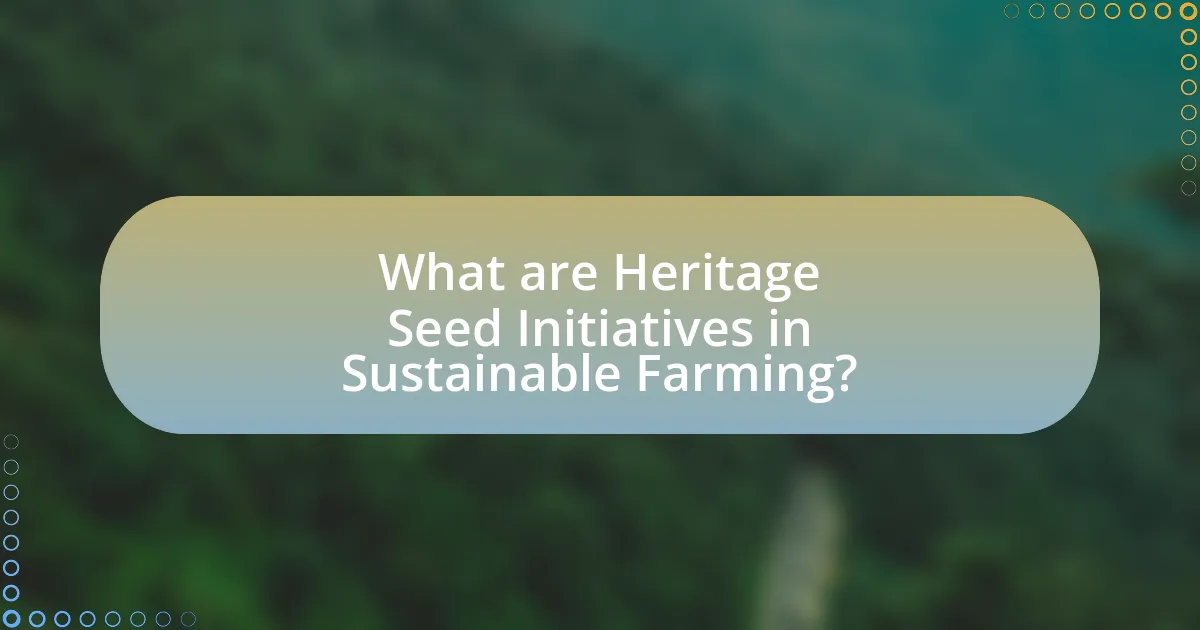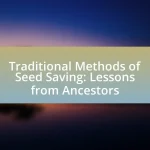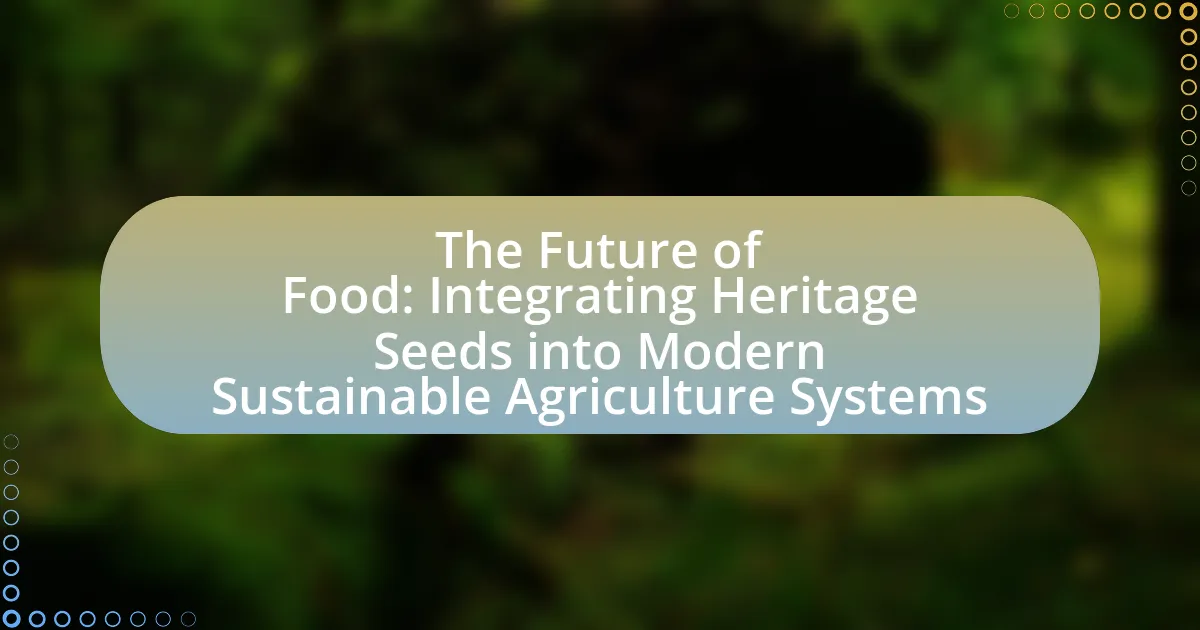Heritage Seed Initiatives in Sustainable Farming focus on preserving traditional seed varieties that enhance genetic diversity, food security, and local ecosystems. The article examines successful case studies, such as the Seed Savers Exchange and the Vavilov Institute, highlighting their contributions to biodiversity and sustainable agricultural practices. It discusses the characteristics of effective initiatives, the role of community involvement and education, and the challenges faced in implementation. Additionally, it explores the economic factors and government policies that influence the adoption of heritage seeds, as well as emerging trends in sustainable agriculture and practical steps individuals can take to support these initiatives.

What are Heritage Seed Initiatives in Sustainable Farming?
Heritage Seed Initiatives in Sustainable Farming are programs aimed at preserving and promoting traditional seed varieties that have been cultivated over generations. These initiatives focus on maintaining genetic diversity, enhancing food security, and supporting local ecosystems by encouraging the use of heirloom seeds that are well-adapted to specific regional conditions. Evidence of their effectiveness can be seen in various community-based projects, such as the Seed Savers Exchange, which has successfully conserved thousands of heirloom varieties and facilitated their distribution among farmers, thereby fostering sustainable agricultural practices and resilience against climate change.
How do heritage seeds contribute to sustainable farming practices?
Heritage seeds contribute to sustainable farming practices by promoting biodiversity and resilience in agricultural systems. These seeds are often well-adapted to local climates and conditions, which enhances their ability to thrive without excessive chemical inputs. For instance, studies have shown that heritage varieties can yield comparable or even superior harvests under organic farming conditions, reducing reliance on synthetic fertilizers and pesticides. Additionally, the use of heritage seeds helps preserve genetic diversity, which is crucial for adapting to changing environmental conditions and combating pests and diseases. This genetic diversity can lead to more robust ecosystems and sustainable agricultural practices over time.
What defines a heritage seed and how is it different from hybrid seeds?
A heritage seed is defined as a seed variety that has been passed down through generations, typically for at least 50 years, and is open-pollinated, meaning it can reproduce itself naturally. In contrast, hybrid seeds are created through controlled cross-pollination of different plant varieties, resulting in offspring that often exhibit specific desirable traits but cannot reliably reproduce those traits in subsequent generations. Heritage seeds maintain genetic diversity and are often better adapted to local growing conditions, while hybrid seeds may offer higher yields but can require specific agricultural practices and inputs.
Why are heritage seeds important for biodiversity in agriculture?
Heritage seeds are crucial for biodiversity in agriculture because they preserve genetic diversity, which enhances ecosystem resilience and adaptability. These seeds represent a wide range of plant varieties that have evolved over time, allowing for greater adaptability to changing environmental conditions and pests. For instance, studies show that diverse crop varieties can lead to improved yields and reduced vulnerability to diseases, as demonstrated in the work of the Food and Agriculture Organization, which emphasizes the role of genetic diversity in food security. By maintaining heritage seeds, farmers can ensure a more sustainable agricultural system that is better equipped to face challenges such as climate change and resource scarcity.
What are the key characteristics of successful heritage seed initiatives?
Successful heritage seed initiatives are characterized by community involvement, biodiversity preservation, and sustainable agricultural practices. Community involvement ensures local farmers and stakeholders actively participate in seed selection and cultivation, fostering a sense of ownership and commitment. Biodiversity preservation is crucial as these initiatives maintain a wide variety of plant genetics, which enhances resilience against pests and climate change. Sustainable agricultural practices, such as organic farming and crop rotation, are integral to these initiatives, promoting soil health and reducing reliance on chemical inputs. Evidence from various case studies indicates that initiatives like the Seed Savers Exchange have successfully implemented these characteristics, leading to increased food security and ecological balance.
How do community involvement and education play a role in these initiatives?
Community involvement and education are crucial in heritage seed initiatives as they foster local engagement and knowledge sharing. These initiatives often rely on community members to participate in seed saving, cultivation, and distribution, which enhances biodiversity and preserves local agricultural practices. Education empowers community members with the skills and knowledge necessary to manage heritage seeds effectively, ensuring sustainable farming practices. For instance, programs that educate farmers about the benefits of heritage seeds have shown increased adoption rates, leading to improved crop resilience and food security. Studies indicate that communities actively engaged in seed initiatives report higher levels of biodiversity and improved agricultural outcomes, demonstrating the effectiveness of combining community involvement with education in sustainable farming practices.
What strategies are employed to promote the use of heritage seeds among farmers?
Strategies employed to promote the use of heritage seeds among farmers include education and awareness campaigns, community seed banks, and government incentives. Education initiatives focus on informing farmers about the benefits of heritage seeds, such as biodiversity, resilience to climate change, and improved taste. Community seed banks facilitate access to heritage seeds, allowing farmers to exchange and share seeds, thus fostering a culture of preservation. Government incentives, such as subsidies or grants for using heritage seeds, encourage farmers to adopt these varieties, ensuring their continued cultivation and support for sustainable farming practices.

What are some notable case studies of successful heritage seed initiatives?
Notable case studies of successful heritage seed initiatives include the Seed Savers Exchange in the United States, which has preserved over 25,000 heirloom varieties since its founding in 1975, promoting biodiversity and sustainable agriculture. Another example is the Vavilov Institute in Russia, which has maintained a vast collection of heritage seeds, contributing to global food security and research on plant genetics. Additionally, the Slow Food movement’s Ark of Taste program highlights local heritage varieties worldwide, advocating for their preservation and use in sustainable farming practices. These initiatives demonstrate the importance of heritage seeds in maintaining agricultural diversity and resilience.
How have specific regions implemented heritage seed initiatives effectively?
Specific regions have implemented heritage seed initiatives effectively through community-based seed banks and educational programs. For instance, in India, the Navdanya movement established over 100 community seed banks, preserving thousands of indigenous seed varieties while promoting biodiversity and sustainable agriculture. This initiative has empowered local farmers by providing access to heritage seeds, which enhances food security and resilience against climate change. Additionally, in Italy, the Slow Food movement has successfully revived traditional seed varieties through its Presidia project, which supports small-scale farmers and promotes local food cultures. These efforts have resulted in increased awareness and appreciation for heritage seeds, fostering a sustainable agricultural ecosystem.
What lessons can be learned from the success of these initiatives in different climates?
Successful heritage seed initiatives in different climates demonstrate the importance of adaptability, community involvement, and biodiversity. Adaptability is crucial as these initiatives often tailor their practices to local environmental conditions, ensuring resilience against climate variability. Community involvement fosters knowledge sharing and strengthens local agricultural practices, as seen in various case studies where farmers collaborate to preserve and cultivate heritage seeds. Biodiversity enhances ecosystem stability, as diverse seed varieties can withstand pests and diseases better than monocultures. For instance, initiatives in regions like the Andes have shown that maintaining a wide range of seed varieties leads to improved food security and agricultural sustainability. These lessons highlight the need for localized approaches that consider environmental and social contexts in sustainable farming practices.
How do local cultures influence the success of heritage seed initiatives?
Local cultures significantly influence the success of heritage seed initiatives by fostering community engagement and preserving traditional agricultural practices. These cultural elements create a strong sense of identity and belonging, which encourages local farmers to participate actively in seed-saving and sharing programs. For instance, in regions where indigenous knowledge and practices are respected, such as in the Andean communities, the preservation of native seeds is often linked to cultural heritage, leading to higher participation rates in heritage seed initiatives. Studies have shown that communities with a rich agricultural history tend to have more robust networks for sharing seeds, which enhances biodiversity and resilience in farming systems.
What challenges have been faced in implementing heritage seed initiatives?
Implementing heritage seed initiatives faces several challenges, including regulatory hurdles, limited funding, and lack of awareness among farmers. Regulatory frameworks often impose restrictions that complicate the cultivation and distribution of heritage seeds, making it difficult for initiatives to gain traction. Limited funding restricts the ability to conduct research, outreach, and education necessary for successful implementation. Additionally, many farmers may lack awareness of the benefits of heritage seeds, leading to resistance against adopting these initiatives. These challenges collectively hinder the growth and sustainability of heritage seed programs.
How do economic factors impact the adoption of heritage seeds?
Economic factors significantly influence the adoption of heritage seeds by affecting farmers’ financial viability and market access. When farmers perceive heritage seeds as economically beneficial—due to lower seed costs, reduced dependency on chemical inputs, and potential premium prices for organic or heritage products—they are more likely to adopt them. For instance, a study by the Food and Agriculture Organization (FAO) highlights that farmers who switch to heritage seeds can save up to 30% on seed costs compared to hybrid varieties, which encourages adoption. Additionally, access to markets that value biodiversity and sustainability can further incentivize farmers to choose heritage seeds, as demonstrated by successful initiatives in regions like India, where local markets have embraced heritage varieties for their unique flavors and cultural significance.
What role do government policies play in supporting or hindering these initiatives?
Government policies significantly influence heritage seed initiatives in sustainable farming by either providing support through funding, regulations, and incentives or hindering progress through restrictive practices and lack of resources. For instance, supportive policies can include grants for farmers who adopt heritage seeds, tax incentives for sustainable practices, and regulations that protect biodiversity, which encourage the use of these seeds. Conversely, policies that impose stringent regulations on seed usage or lack funding for agricultural innovation can stifle these initiatives. Evidence from various countries shows that nations with favorable agricultural policies, such as Italy’s support for traditional seed varieties, have seen a resurgence in heritage seed usage, while those with restrictive policies have experienced declines in biodiversity and sustainable practices.

How can farmers and communities replicate successful heritage seed initiatives?
Farmers and communities can replicate successful heritage seed initiatives by establishing seed banks, promoting local seed saving practices, and fostering community engagement in agricultural education. Seed banks serve as repositories for diverse heritage seeds, ensuring their preservation and availability for future planting. Local seed saving practices encourage farmers to collect and share seeds from their best-performing crops, enhancing biodiversity and resilience. Community engagement through workshops and training programs can educate farmers about the benefits of heritage seeds, as demonstrated by initiatives like the Seed Savers Exchange, which has successfully preserved thousands of heirloom varieties since its inception in 1975. These strategies collectively empower communities to sustain and expand heritage seed initiatives effectively.
What best practices should be followed when starting a heritage seed initiative?
To start a heritage seed initiative, it is essential to prioritize the preservation of genetic diversity by selecting a wide range of heirloom varieties that are well-suited to the local climate and soil conditions. This practice ensures that the initiative can maintain a robust gene pool, which is critical for resilience against pests, diseases, and climate variability. Additionally, engaging with local communities and farmers fosters knowledge sharing and collaboration, enhancing the initiative’s sustainability and relevance. Research indicates that initiatives that incorporate community involvement have higher success rates, as seen in the Seed Savers Exchange, which has successfully preserved thousands of heirloom varieties through community engagement and education.
How can collaboration among farmers enhance the success of heritage seed programs?
Collaboration among farmers enhances the success of heritage seed programs by facilitating knowledge sharing, resource pooling, and collective marketing efforts. When farmers work together, they can exchange best practices regarding seed preservation and cultivation techniques, which leads to improved crop resilience and biodiversity. For instance, a study by the Food and Agriculture Organization (FAO) highlights that collaborative networks among farmers can increase the genetic diversity of crops, making them more adaptable to changing environmental conditions. Additionally, pooling resources allows farmers to access better tools and technologies, reducing individual costs and increasing overall efficiency. Collective marketing strategies enable farmers to reach broader markets, ensuring that heritage seeds gain visibility and demand, ultimately supporting the sustainability of these programs.
What resources are available for communities looking to implement these initiatives?
Communities looking to implement heritage seed initiatives in sustainable farming can access various resources, including local agricultural extension services, non-profit organizations focused on sustainable agriculture, and online platforms that provide educational materials and funding opportunities. For instance, organizations like Seed Savers Exchange offer seed preservation resources and community networking. Additionally, the USDA provides grants and technical assistance for sustainable farming practices, which can support the establishment of heritage seed programs. These resources are essential for communities to successfully implement and sustain their initiatives.
What are the future prospects for heritage seed initiatives in sustainable farming?
Heritage seed initiatives in sustainable farming are expected to grow significantly in the future due to increasing consumer demand for organic and locally sourced food. These initiatives promote biodiversity, enhance soil health, and support local economies by preserving traditional varieties that are often more resilient to climate change. According to a report by the Food and Agriculture Organization, the global market for organic food is projected to reach $320 billion by 2025, indicating a strong trend towards sustainable agricultural practices that include heritage seeds. This growth is further supported by initiatives like the Seed Savers Exchange, which has successfully preserved thousands of heirloom varieties, demonstrating the viability and importance of heritage seeds in modern agriculture.
How can technology support the preservation and distribution of heritage seeds?
Technology can support the preservation and distribution of heritage seeds through digital databases, genetic analysis, and online marketplaces. Digital databases enable the cataloging of seed varieties, ensuring that information about their characteristics and growing conditions is accessible to farmers and researchers. Genetic analysis tools, such as DNA sequencing, help in identifying and maintaining the genetic diversity of heritage seeds, which is crucial for their preservation. Online marketplaces facilitate the distribution of these seeds to a broader audience, allowing farmers to access rare varieties that may not be available locally. For instance, platforms like Seed Savers Exchange connect growers with heritage seed varieties, promoting biodiversity and sustainable agriculture practices.
What trends are emerging in the global movement towards sustainable agriculture?
Emerging trends in the global movement towards sustainable agriculture include the increased adoption of regenerative farming practices, the rise of agroecology, and a focus on biodiversity through heritage seed initiatives. Regenerative farming emphasizes soil health, carbon sequestration, and ecosystem restoration, which are supported by studies showing that these practices can enhance productivity and resilience against climate change. Agroecology integrates ecological principles into agricultural systems, promoting local knowledge and sustainable practices, as evidenced by successful case studies in various regions. Additionally, heritage seed initiatives are gaining traction, preserving genetic diversity and traditional farming methods, which contribute to food security and resilience. These trends reflect a collective shift towards more sustainable, equitable, and environmentally friendly agricultural practices globally.
What practical steps can individuals take to support heritage seed initiatives?
Individuals can support heritage seed initiatives by participating in seed saving, which involves collecting and preserving seeds from heirloom plants for future planting. This practice not only maintains genetic diversity but also fosters local agricultural resilience. Additionally, individuals can purchase heritage seeds from reputable suppliers, ensuring that their gardening choices contribute to the sustainability of these varieties. Engaging in community-supported agriculture (CSA) programs that prioritize heritage seeds further strengthens local food systems. Supporting educational workshops on seed saving and heritage gardening also empowers others to participate in these initiatives, creating a broader impact. According to the Seed Savers Exchange, preserving heirloom seeds helps maintain biodiversity and supports sustainable farming practices, making these actions vital for future agricultural sustainability.





